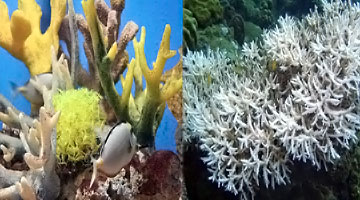 The Philippine Council for Agriculture, Aquatic and Natural Resources Research and Development (PCAARRD) advises sea-loving Filipinos to watch out for coral bleaching in the reefs.
The Philippine Council for Agriculture, Aquatic and Natural Resources Research and Development (PCAARRD) advises sea-loving Filipinos to watch out for coral bleaching in the reefs.
Coral bleaching is the whitening of the corals resulting from the death and or reduction in the photosynthetic pigment (color) in the zooxanthellae, the organism that gives color to corals. Corals whiten or lose their color because they are stressed.
Coral stress may be due to high sea surface temperatures, sedimentation, sub-aerial exposure, freshwater dilution, and intense solar radiation.
In an information bulletin released by PCAARRD, the agency explained that of these factors, the combined effects of high sea surface temperatures and solar radiation are the major causes of massive coral bleaching all over the world.
There are three stages of coral bleaching within a site — onset, peak, and late. At the onset, corals are patchy within colonies and within a reef zone. Branching corals are the ones likely to bleach first, but coral polyps are still evident. The coral polyp is a sack with a stomach and mouth surrounded by tentacles that catch food.
At the peak stage, almost all corals whiten from shallow to deep. Some corals may be fluorescent in color and there are soft corals. Anemones and even clams start to bleach or whiten as well.
Corals at the late stage of bleaching are discolored. The coral polyps are dead and algae starts to set in.
To help keep corals healthy, respect all local guidelines, recommendations, and regulations when visiting areas with coral reefs. Report any signs of bleaching in any area visited.
For more information, on Coral Bleaching Watch, log on to Facebook and look for Philippine Coral Bleaching Watch.
